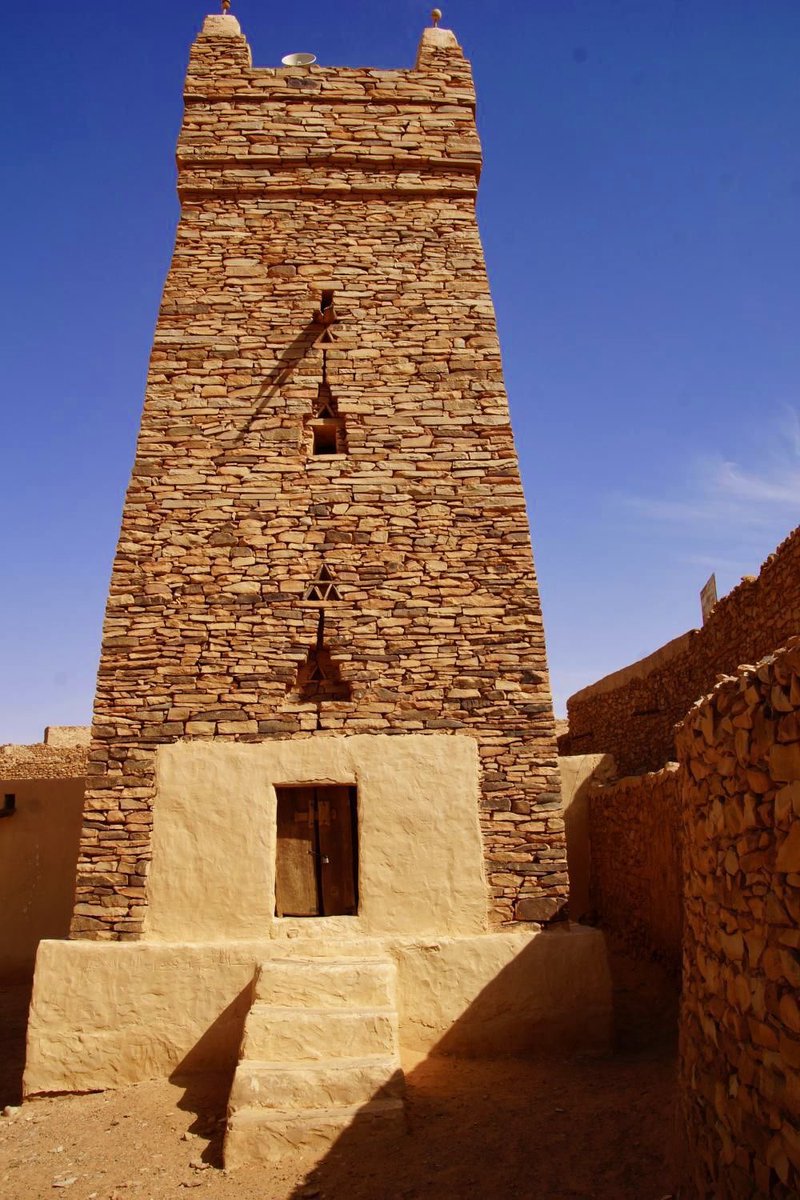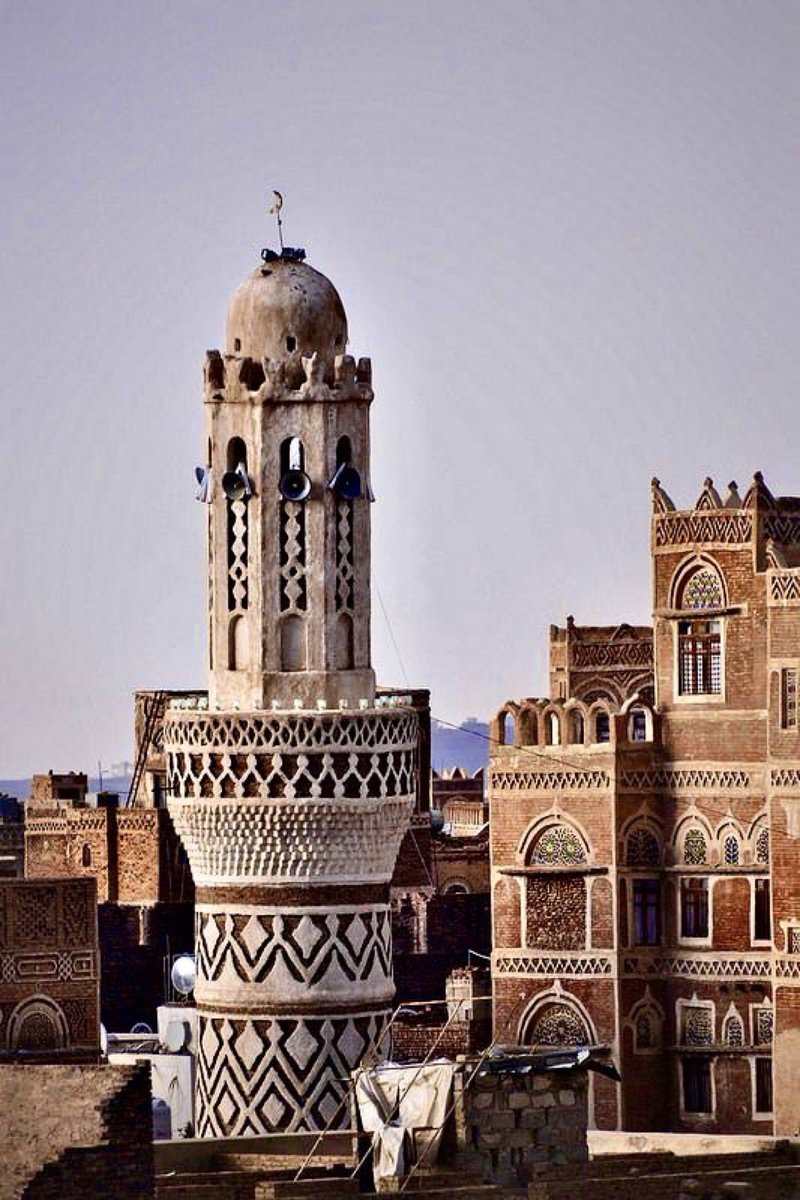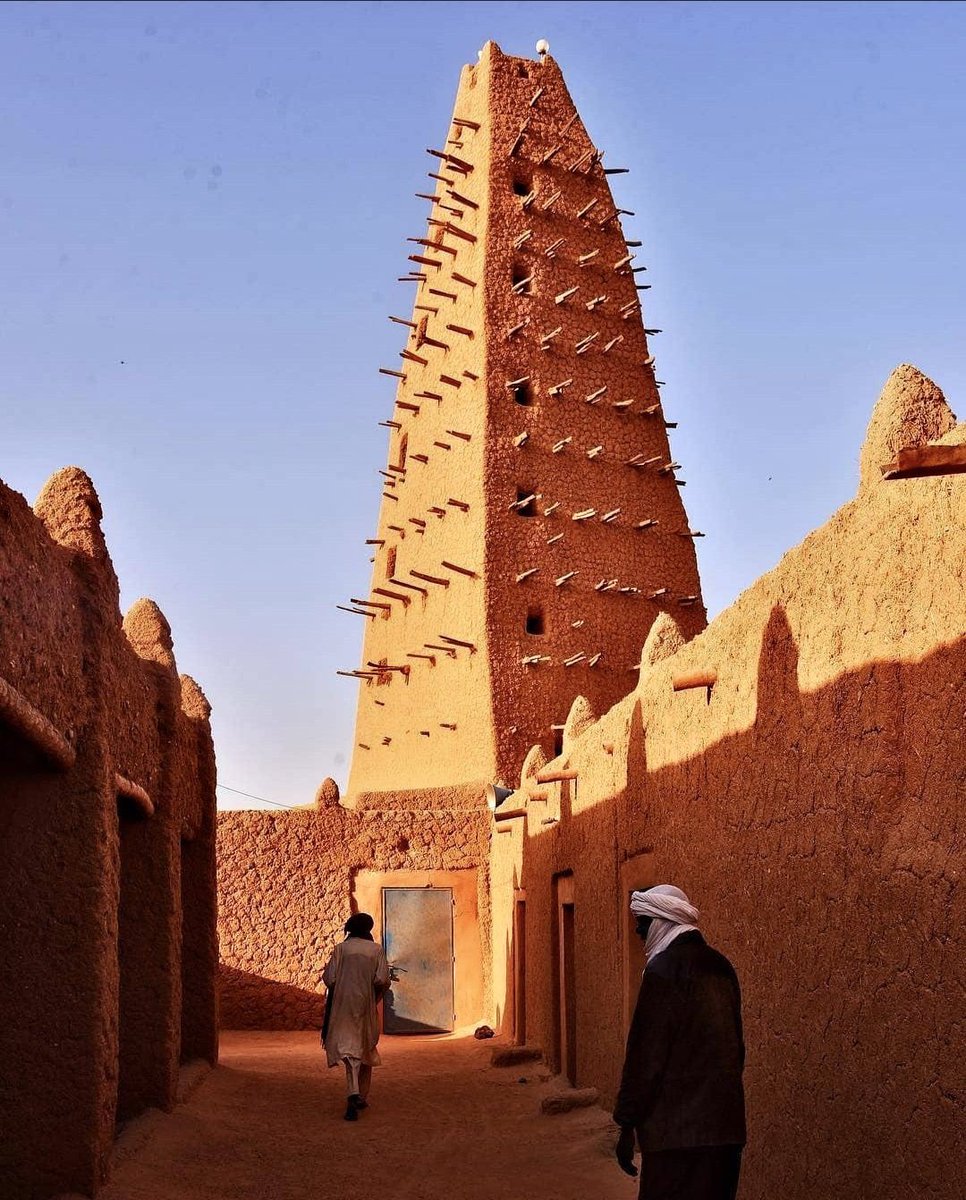The word Minaret comes from the Arabic word manarah, meaning lighthouse. Its function is to be a beacon of hope & project the Muslim call to prayer (adhan). They come in diverse styles & varying forms.
Here are 24 magnificent Minarets across the world #JummaMubarak
A thread…
Here are 24 magnificent Minarets across the world #JummaMubarak
A thread…

1/ Minaret of the Great Mosque of Samarra, Iraq
Built by the Abbasid caliph Al-Mutawakkil (reigned 847–861) around 850, it was probably the largest mosque in the world. The minaret is built in the shape of a cone, wrapped in a spiraling ramp that leads to the top.
Built by the Abbasid caliph Al-Mutawakkil (reigned 847–861) around 850, it was probably the largest mosque in the world. The minaret is built in the shape of a cone, wrapped in a spiraling ramp that leads to the top.

2/ Minarets of Green Mosque, Turpan, China
Located in the center of the XinJiang province in an area known as the "Turpan Depression", the lowest & hottest place in China.
This a close up of the entrance and two central minarets to 'the green mosque'
Located in the center of the XinJiang province in an area known as the "Turpan Depression", the lowest & hottest place in China.
This a close up of the entrance and two central minarets to 'the green mosque'

3/ Minaret of Hassan II Mosque, Casablanca, Morocco
It is the second largest functioning mosque in Africa. Its minaret is the world's second tallest minaret at 210 metres. Completed in 1993, it was designed by Michel Pinseau under the guidance of King Hassan II
It is the second largest functioning mosque in Africa. Its minaret is the world's second tallest minaret at 210 metres. Completed in 1993, it was designed by Michel Pinseau under the guidance of King Hassan II

4/ Minaret of Al-Zaytuna Mosque, Tunisia
Also known as Ez-Zitouna Mosque, and El-Zituna Mosque, is a major mosque at the center of the Medina of Tunis. The mosque is the oldest in Tunis, built in the 8th century & covers an area of 5,000 square metres with nine entrances
Also known as Ez-Zitouna Mosque, and El-Zituna Mosque, is a major mosque at the center of the Medina of Tunis. The mosque is the oldest in Tunis, built in the 8th century & covers an area of 5,000 square metres with nine entrances

5/ Minaret of Wazir Khan Mosque, Pakistan
The construction began in 1634 C.E. & completed in 1641. Considered to be the most ornately decorated Mughal-era mosque it is renowned for its intricate faience tile work known as kashi-kari, as well as embellished frescoes
The construction began in 1634 C.E. & completed in 1641. Considered to be the most ornately decorated Mughal-era mosque it is renowned for its intricate faience tile work known as kashi-kari, as well as embellished frescoes

6/ Minaret of Chinguetti Mosque, Adrar, Mauritania, 13th-14th century
The minaret of this ancient structure is supposedly the 2nd oldest in continuous use anywhere in the Muslim world. The mosque is popularly considered the national emblem of the Islamic Republic of Mauritania
The minaret of this ancient structure is supposedly the 2nd oldest in continuous use anywhere in the Muslim world. The mosque is popularly considered the national emblem of the Islamic Republic of Mauritania

7/ Minaret of The Shah Mosque, Isfahan, Iran
Located on the south side of Naghsh-e Jahan Square. It was built during the Safavid dynasty in 1611, under the order of Shah Abbas I of Persia. It is regarded as one of the masterpieces of Persian architecture in the Islamic era
Located on the south side of Naghsh-e Jahan Square. It was built during the Safavid dynasty in 1611, under the order of Shah Abbas I of Persia. It is regarded as one of the masterpieces of Persian architecture in the Islamic era

8/ Minaret of Asma Bint Alawi Mosque, Muscat, Oman
Inspired by Moroccan architectural styles. It features a central colourful decorated dome, as well as a clock tower as its minaret. The mosque also has a fountain in its courtyard, & maze-shaped flower basin
Inspired by Moroccan architectural styles. It features a central colourful decorated dome, as well as a clock tower as its minaret. The mosque also has a fountain in its courtyard, & maze-shaped flower basin

9/ Minaret & Archaeological Remains of Jam, Afghanistan
The 65m-tall Minaret of Jam dates to the 12th century. Covered in elaborate brickwork with a blue tile inscription it is noteworthy for the quality of its architecture & decoration reflecting the regional artistic tradition
The 65m-tall Minaret of Jam dates to the 12th century. Covered in elaborate brickwork with a blue tile inscription it is noteworthy for the quality of its architecture & decoration reflecting the regional artistic tradition

10/ Minaret of The Great Mosque of Paris, France
The architecture & garden of the Mosque is inspired by the Alhambra in Grenada. The mosque was built to pay tribute to the 100,000 Muslim fighters who died for France in the First World War.
The architecture & garden of the Mosque is inspired by the Alhambra in Grenada. The mosque was built to pay tribute to the 100,000 Muslim fighters who died for France in the First World War.

11/ Minarets of Beemapally Mosque, Kerala, India
Beemapally is a region within the city of Thiruvananthapuram in the state of Kerala, India. This stunning pink mosque was built to honour Syedunnisa Beema Beevi who travelled from Arabia to establish Islam in Kerala
Beemapally is a region within the city of Thiruvananthapuram in the state of Kerala, India. This stunning pink mosque was built to honour Syedunnisa Beema Beevi who travelled from Arabia to establish Islam in Kerala

12/ Kalta Minor Minaret, Khiva, Uzbekistan
One of the last great blue buildings in the Khanate of Khiva was Kalta Minor. This had to be the tallest structure in Khiva & in the whole of Central Asia. Works ended abruptly in 1855, leaving this beautiful minaret unfinished
One of the last great blue buildings in the Khanate of Khiva was Kalta Minor. This had to be the tallest structure in Khiva & in the whole of Central Asia. Works ended abruptly in 1855, leaving this beautiful minaret unfinished

13/ Minaret of the Great Mosque of Sana'a, Yemen
One of the oldest mosques in the world, it is said to have been founded in the early Islamic period, suggested to be in 633. The earliest recorded renovations occurred under Caliph al-Alid I in the early 8th century
One of the oldest mosques in the world, it is said to have been founded in the early Islamic period, suggested to be in 633. The earliest recorded renovations occurred under Caliph al-Alid I in the early 8th century

14/ Minaret of The Great Mosque of Touba, Senegal.
It was founded by Sheikh Ahmad Bamba in 1887 and completed in 1963. It is the largest building in the city and one of the largest mosques in Africa, with a capacity of 7,000.
It was founded by Sheikh Ahmad Bamba in 1887 and completed in 1963. It is the largest building in the city and one of the largest mosques in Africa, with a capacity of 7,000.

15/ Minaret of Sultan Ahmed Mosque, Istanbul, Turkey
Also known as the Blue Mosque, it is an Ottoman-era historical imperial mosque. A functioning mosque, it also attracts large numbers of tourist visitors. It was constructed between 1609 & 1616 during the rule of Ahmed I.
Also known as the Blue Mosque, it is an Ottoman-era historical imperial mosque. A functioning mosque, it also attracts large numbers of tourist visitors. It was constructed between 1609 & 1616 during the rule of Ahmed I.

16/ Minaret of An Nurumi Mosque, Indonesia
An Indonesian mosque styled after St. Basil's Cathedral. Some call it the “Candy Mosque,” because of its colorful domed spires & minaret that resemble lollipops.
An Indonesian mosque styled after St. Basil's Cathedral. Some call it the “Candy Mosque,” because of its colorful domed spires & minaret that resemble lollipops.

17/ Minaret of Al Azizia Mosque, Mecca, Saudia Arabia
Al Azizia mosque is a majestic Islamic style building of 23,140m2, located just minutes away from Al-Haram in Mecca, Saudi Arabia, which is capable of accommodating up to 25,000 worshippers
Al Azizia mosque is a majestic Islamic style building of 23,140m2, located just minutes away from Al-Haram in Mecca, Saudi Arabia, which is capable of accommodating up to 25,000 worshippers

18/ Minaret of Spiral Mosque, Doha, Qatar
The mosque of the Kassem Darwish Fakhroo Islamic Centre is a recent construction & one of Doha's famous landmarks. It is not a traditional Qatari mosque but a replica of the Great Mosque of Al-Mutawwakil, Samarra in Iraq
The mosque of the Kassem Darwish Fakhroo Islamic Centre is a recent construction & one of Doha's famous landmarks. It is not a traditional Qatari mosque but a replica of the Great Mosque of Al-Mutawwakil, Samarra in Iraq

19/ Minaret of Hamoudi mosque (1906), City of Djibouti, Djibouti
Every city has at least one iconic building, and this is the closest thing to it in Djibouti city what with the mosque's size and prominent location above the main square
Every city has at least one iconic building, and this is the closest thing to it in Djibouti city what with the mosque's size and prominent location above the main square

20/ Minaret of Äcem Masjid, Kazan, Tatarstan, Russia.
Commissioned in 1887- 1880 by Tatar merchant, Mortaza Äcimev.
Commissioned in 1887- 1880 by Tatar merchant, Mortaza Äcimev.

21/ Minaret of Agadez Mosque, Tchirozerine Department, Niger, 1515
It was made of clay and is the tallest mud-brick structure in the world. The city was built in 1515 at the time when the city was captured by the Songhai Empire. It was restored and some of it was rebuilt in 1844
It was made of clay and is the tallest mud-brick structure in the world. The city was built in 1515 at the time when the city was captured by the Songhai Empire. It was restored and some of it was rebuilt in 1844

22/ Minaret of The Ketchaoua Mosque, Algeria
While Algeria was under French colonial rule, this historic mosque was turned into a Christian cathedral. After the end of the Algerian War of Independence in 1962, it was returned to its original purpose, as a mosque.
While Algeria was under French colonial rule, this historic mosque was turned into a Christian cathedral. After the end of the Algerian War of Independence in 1962, it was returned to its original purpose, as a mosque.

23/ Minarets of Jami Ul-Alfar Mosque in Colombo, Sri Lanka.
This distinctive colourful red & white striped two-storey building, with a clock tower was built in 1909. Its architecture was inspired by the pomegranate, which is manifested in the building colour & shape of the domes
This distinctive colourful red & white striped two-storey building, with a clock tower was built in 1909. Its architecture was inspired by the pomegranate, which is manifested in the building colour & shape of the domes

24/ Minaret of Al-Azhar Mosque, Cairo, Egypt
One of the oldest and most important mosques in Egypt. It is considered a source for enlightenment. The cornerstone of Al-Azhar Mosque was laid on Ramadan 14, 359 AH - 970 AD
One of the oldest and most important mosques in Egypt. It is considered a source for enlightenment. The cornerstone of Al-Azhar Mosque was laid on Ramadan 14, 359 AH - 970 AD

Discover more about Minarets & Mosques:
baytalfann.com/post/minarets
baytalfann.com/post/minarets
• • •
Missing some Tweet in this thread? You can try to
force a refresh






















